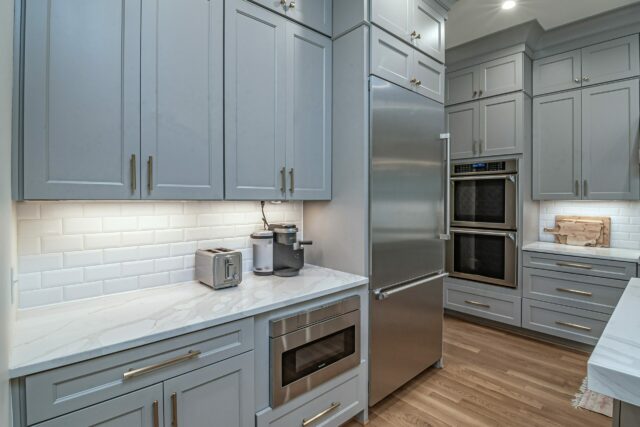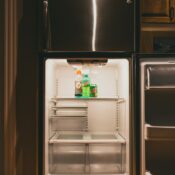A fridge full of food is the ultimate goal for most of us, isn’t it? But have you ever asked yourself, “Is it better to keep a fridge full or empty?” Of course, with the rising energy costs and electricity bills, you want to save as much as possible when using your fridge. And this may tempt you to stack your fridge with as much food as possible; after all, the more food you store, the more money you can save since you won’t have to keep buying new foods.

But does keeping your fridge full really save on costs? Is it really worth it? This article will help you find the answer to this question and provide tips on keeping your refrigerator running efficiently for a long time. Let’s get started!
Is it Better to Keep a Fridge Full or Empty?
| No, it is not better to keep a fridge full than empty. And neither is it better to keep the fridge empty than full. On the contrary, a fridge works better and most efficiently when it is 3/4 (or 75%) full. A fridge that is 3/4 full has unhindered air circulation and a smooth airflow that ensures the optimal functioning of the fridge. Besides, food stored in such a fridge absorbs the cold much more efficiently, keeping it fresh and healthy for longer. Therefore, you should always keep your refrigerator 75% full to ensure its peak performance. |
Stacking food in the fridge indeed ensures that we have food at our disposal, minimizing all those trips to the mall or the market. However, fully stuffed fridges lack enough airflow and may make it impossible to keep everything cold. In turn, this increases the chances of food spoiling while stored in the fridge. On the other hand, a fridge that is entirely or nearly empty won’t work as efficiently.
RELATED = = = > The Best Way to Clean Refrigerator Coils
How Does an Empty Fridge Work?
You will open the fridge multiple times throughout the day to put in new items, check for stuff or take something out. While such simple opening and closing of the fridge door might not seem like much, it leads to a lot of air transfer in the fridge.
If your fridge is empty (or nearly empty), it means that there is a lot of air space inside. Therefore, when you open the door, cool air flowing inside the refrigerator flows to the outside. In turn, room temperature air outside the fridge’s environment flows inside to fill the fridge. And since the refrigerator has to cool the room temperature air that enters, it works extra hard to cool all the air in the large empty space; this means more energy bills for you!
How Does a Full Fridge Work?
Unlike an empty or nearly empty fridge, the most part of a full fridge is not air. When the fridge door is opened, the appliance only loses the cool air that surrounds the food. Also, just minimal room temperature air enters the fridge. Therefore, when the door is closed, the fridge takes less time and energy to cool the minimal warm air that enters the refrigerator.
Simply put, the many cold foodstuffs and items stored in the fridge act as a cold bank. When warm air enters the refrigerator, these items cool the air quickly, minimizing the overall energy used.
RELATED = = = > Should a Fridge Door Be Left Open?
How Full Should Your Refrigerator Be?
Now you know that a fridge saves on costs and energy bills when full. But does this mean you should overstuff your refrigerator, filling it with many food items until there is no more space left? Absolutely not.
While a full fridge reduces the amount of energy used to cool the interior, cramming it and filling every corner with foodstuffs does more harm than good; it makes the fridge’s job much more difficult and less effective. This is why it is recommended that you keep your refrigerator up to 3/4 full at all times. Also, ensure not to block any vents in the fridge while stocking it up.
But what if yours is an oversize fridge and you just can’t manage to fill it up 75%? Well, you could try stocking up the refrigerator with gallon jugs or regular water bottles. Alternatively, use coffee, flour, or even batteries to fill the empty space; the options are endless!
What Happens If You Cram a Fridge?
Overfilling a fridge with too many items usually leads to problems. First, if too many items are stored in the freezer, some of these could block the vents. And since these vents work to bring in enough airflow into the freezer, blocking them would result in limited airflow and circulation in the fridge.
When the fridge does not have enough airflow and circulation of cold air, the temperature of the food stored in it increases. In turn, the fridge begins working harder to cool the food and restore the flow of cold air inside. In the long run, this usually results in higher energy consumption and increased electricity bills. And the more you cram your fridge, the more the temperatures increase and the more energy bills you incur.
Besides, when crammed food in the fridge blocks vents, it could lead to damaging of the refrigerator. After all, good airflow is necessary for the optimal functioning of the fridge. Hence, when good airflow in the fridge is inhibited, it leads to the appliance overworking and even getting damaged in the process.
Conclusion
Is it better to keep a fridge full or empty? The truth of the matter is that a fridge works best when 3/4 full. Otherwise, stacking the refrigerator with too many items, or leaving it nearly empty, won’t help you cut costs. On the contrary, doing so will only increase your energy bills and reduce the efficiency of your appliance. Therefore, always keep your fridge 3/4 full to ensure it gives you the best performance for the longest time possible!
READ ME NEXT = = = > Should My Clothes Smell Like Detergent After Washing?

